boot insulation guide

Boot insulation is a crucial feature for footwear, especially in cold conditions, providing warmth and comfort. Insulated boots use materials like Thinsulate or synthetic fills to retain heat, making them ideal for outdoor activities. This guide explains their importance, materials, and how to choose the right pair for your needs, ensuring optimal performance in freezing environments while maintaining durability and style.
What is Boot Insulation?
Boot insulation refers to materials or technologies incorporated into footwear to retain warmth, especially in cold conditions. Common types include Thinsulate and synthetic insulation, with levels often measured in grams (e.g., 200g or 400g) to indicate warmth for various activities.
Why is Boot Insulation Important?
Boot insulation is essential for protecting feet from cold temperatures, preventing heat loss, and ensuring comfort during outdoor activities. It helps maintain warmth in freezing conditions, reducing the risk of discomfort or health issues like frostbite. Insulated boots are ideal for activities such as hiking, work, or casual use in winter, providing reliable performance while keeping feet dry and cozy in cold environments.

How Boot Insulation Works
Boot insulation works by trapping warm air close to the foot, reducing heat loss, and preventing cold air from penetrating the boot, ensuring warmth and comfort in cold conditions while managing moisture effectively.
Materials Used in Boot Insulation
Boot insulation relies on high-performance materials like Thinsulate, synthetic fills, and natural fibers such as wool. These materials trap warm air, prevent heat loss, and block cold penetration. Synthetic insulation, including PrimaLoft and Zylet, offers durability and moisture-wicking properties, while natural options provide exceptional warmth. The choice of material depends on activity level, temperature, and personal preference, ensuring optimal comfort and protection in cold environments.
Thinsulate Technology and Other Insulation Types
Thinsulate is a lightweight, breathable insulation that traps warmth without bulk. Other popular types include PrimaLoft, known for its water-resistant properties, and Zylet, offering softness and durability. Synthetic materials like Heatseeker and Opti-Warm also provide excellent warmth retention. These technologies ensure boots remain warm, dry, and comfortable in cold conditions, catering to different needs and preferences for outdoor enthusiasts and workers alike.
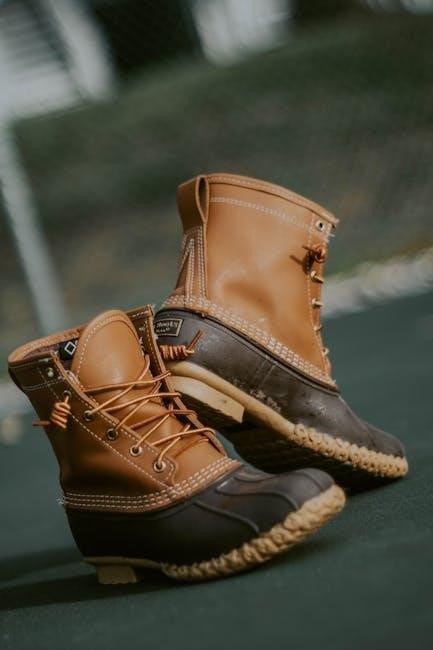
Understanding Insulation Ratings
Insulation ratings indicate the level of warmth and protection insulated boots provide against cold conditions. Higher ratings offer greater thermal insulation, making them suitable for extreme cold environments and activities.
What Do Insulation Ratings Mean?
Insulation ratings measure the warmth and thermal performance of insulated boots. Typically expressed in grams (e.g;, 200g, 400g), these ratings indicate the amount of insulation material used. Higher ratings provide greater warmth, suitable for extreme cold, while lower ratings offer lighter, more flexible options for milder conditions. Understanding these ratings helps users select boots that match their activity level and environmental needs effectively.
200g vs. 400g: Choosing the Right Insulation Level
The 200g insulation level offers lightweight warmth for cool to moderately cold conditions, ideal for active pursuits like hiking. In contrast, 400g provides superior warmth for extreme cold, suited for stationary or low-activity use. The choice depends on your activity level, temperature exposure, and personal comfort preferences, ensuring optimal performance without compromising mobility or heat retention in varying environments.
Key Factors to Consider When Selecting Insulated Boots
When choosing insulated boots, consider fit, comfort, and intended activity. Ensure they are waterproof and durable for your needs, balancing warmth with mobility for optimal performance and satisfaction.
Fit and Comfort
Proper fit is crucial for insulated boots to ensure comfort and prevent blisters. Comfort depends on cushioning and flexibility, while fit affects heat distribution. Consider sock thickness and break-in time. Materials like Thinsulate offer warmth without bulk, enhancing mobility. Prioritize boots that balance insulation with a snug, flexible fit for optimal comfort during extended wear.
Activity and Usage
Choosing insulated boots depends on your activity and environment. For hiking or outdoor adventures, lightweight insulation like 200g Thinsulate is ideal. For heavy-duty work or extreme cold, 400g insulation offers superior warmth. Consider your activity type, as high-intensity tasks may require less bulk, while stationary work in freezing conditions demands maximum insulation. Match your boot choice to your activity for optimal performance and comfort.
Waterproofing and Durability
Waterproofing is essential for insulated boots to prevent water from compromising insulation and warmth. Durable materials like waterproof leather or rubber outsoles ensure longevity and performance in harsh conditions. A waterproof membrane, such as Gore-Tex, enhances protection, while reinforced stitching and sturdy soles provide added resilience. Durable boots withstand rough terrains and heavy use, maintaining comfort and insulation over time. This combination ensures reliable performance in cold and wet environments.
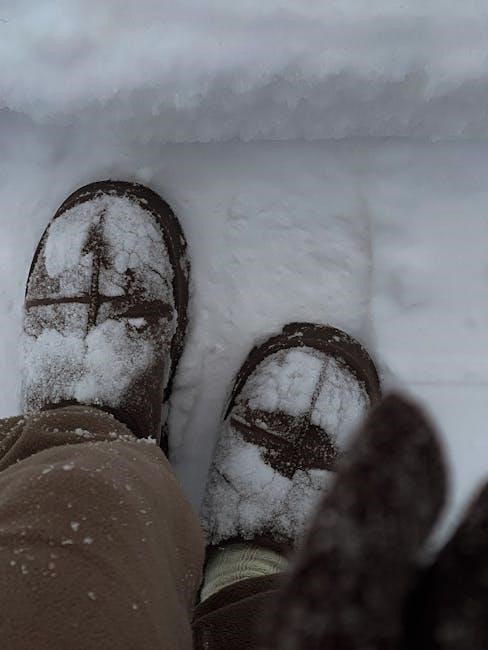
Popular Insulation Materials
Insulated boots often feature materials like Thinsulate, PrimaLoft, and Zylet, known for their ability to retain warmth while remaining lightweight and breathable. These materials are durable and water-resistant, ensuring long-lasting performance in cold conditions.
Synthetic vs. Natural Insulation
Synthetic insulation, such as Thinsulate or PrimaLoft, is lightweight, breathable, and moisture-wicking, making it ideal for active use. Natural insulation, like down, offers excellent warmth but can be bulky and less durable when wet. Synthetic options are generally more versatile and easier to maintain, while natural insulation is chosen for its superior warmth-to-weight ratio in dry conditions.
PrimaLoft, Zylet, and Other Alternatives
PrimaLoft and Zylet are popular synthetic insulations known for their lightweight warmth and moisture-wicking properties; PrimaLoft is highly water-resistant, while Zylet excels in retaining heat in wet conditions. Other alternatives include Polarguard and Holofill, which offer similar performance. These materials are often blended for enhanced durability and comfort, making them versatile choices for insulated boots designed for various outdoor and work environments.
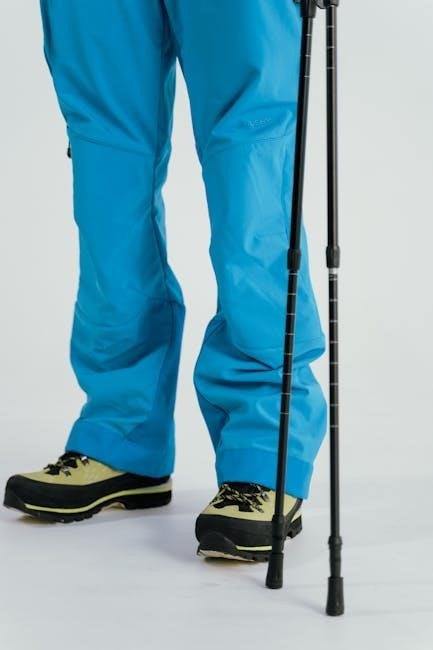
How to Choose the Right Boots for Your Needs
Selecting the right insulated boots involves considering your activity type, insulation level, and fit. Choose 200g for moderate cold and 400g for extreme conditions, ensuring waterproofing and durability.
Insulated Boots for Hiking and Outdoor Activities
For hiking and outdoor activities, choose boots with insulation levels like 400g for extreme cold. Look for waterproofing, durable outsoles, and good traction. Opt for lightweight materials such as Thinsulate or PrimaLoft, which provide warmth without compromising mobility. Ensure a snug fit to prevent blisters and maximize comfort during long treks. Consider boots designed for specific terrains, such as snowy or muddy conditions, to enhance performance and safety.
Work Boots with Insulation
Insulated work boots are essential for cold environments, combining durability with warmth. Look for CSA-approved options featuring waterproof leather and puncture-resistant soles. Insulation ratings like 200g or 400g provide varying levels of warmth, while thermal insoles enhance comfort. These boots are ideal for construction or outdoor jobs, ensuring safety and comfort in freezing conditions without compromising on protection or performance.
Casual and Everyday Insulated Boots
Casual insulated boots offer warmth and style for everyday wear. They often feature lightweight insulation like Thinsulate or PrimaLoft, providing comfort without bulk. Perfect for cold commutes or casual outings, these boots blend durability with fashion. Water-resistant designs and cushioned insoles ensure all-day comfort. Versatile and practical, they are ideal for daily use, keeping feet warm and dry in chilly conditions while maintaining a sleek appearance.
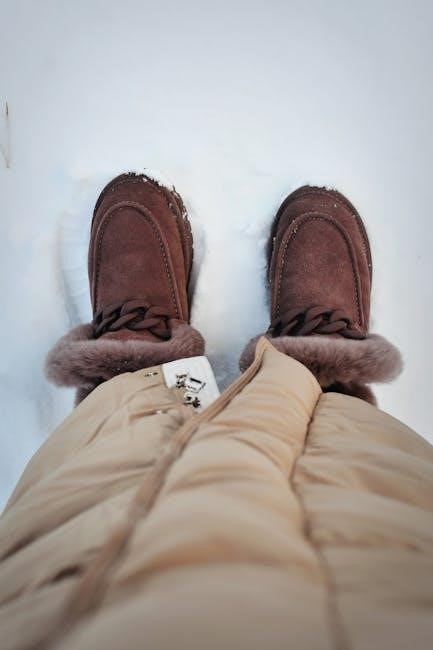
Maintenance and Care of Insulated Boots
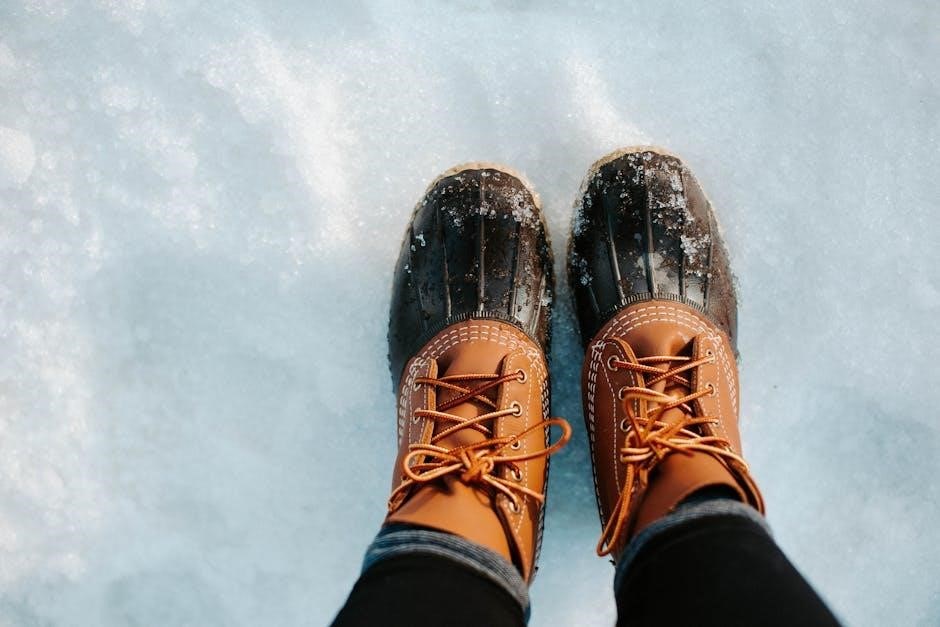
Maintenance and Care of Insulated Boots
Regular cleaning and waterproofing extend the life of insulated boots. Use mild soap and avoid harsh chemicals. Store in a dry, cool place to prevent damage and maintain insulation effectiveness. Proper care ensures long-lasting warmth and performance, keeping your boots in great condition for years of reliable use.
Cleaning and Waterproofing
Regular cleaning and waterproofing are essential to maintain the performance of insulated boots; Use mild soap and water to remove dirt, avoiding harsh chemicals that can damage materials. After cleaning, apply a waterproofing spray or cream to protect the exterior. Allow boots to dry naturally, away from direct heat, to preserve insulation and waterproofing effectiveness. Proper care ensures durability and optimal performance in wet and cold conditions.
Storing Insulated Boots
Proper storage is key to maintaining the quality of insulated boots. Clean boots thoroughly before storage to prevent dirt buildup. Avoid storing in direct sunlight or near heat sources, as this can degrade insulation. Use shoe trees to retain shape and stuff with paper to absorb moisture. Store in a cool, dry place, away from plastic bags to prevent humidity. Proper care ensures long-lasting performance and insulation effectiveness.
FAQs About Boot Insulation
Common questions about insulated boots include understanding insulation ratings, choosing the right material, and maintaining warmth in extreme cold. This section addresses key concerns and provides clear answers to help users make informed decisions about their footwear needs for cold weather activities and work environments.
Common Questions Answered
FAQs about boot insulation often include questions like: What do insulation ratings mean?, How do I choose the right insulation level?, and What materials are best for cold weather?. Users also ask about maintaining warmth in wet conditions and how to care for insulated boots. This section provides clear, concise answers to these common inquiries, helping you make informed decisions for your footwear needs.
Myths and Misconceptions
Some believe thicker insulation always means better warmth, but this can compromise mobility. Others think all insulated boots are waterproof, which isn’t true. Many assume synthetic insulation is less effective than natural materials, but modern synthetics often outperform. Understanding these myths helps you make informed choices and avoid common pitfalls when selecting insulated boots for your specific needs and conditions.
Selecting the right insulated boots involves understanding your needs, activity type, and environment. Balance warmth, mobility, and durability to ensure comfort and performance in cold conditions. Proper care extends their lifespan.
Boot insulation enhances warmth and comfort in cold environments, with materials like Thinsulate and synthetic fills. Understanding insulation ratings, such as 200g vs. 400g, helps tailor choices to specific needs. Fit, activity type, and waterproofing are crucial factors. Proper care, including cleaning and storage, extends boot lifespan. Balancing durability, mobility, and insulation ensures optimal performance for outdoor activities and work settings.
Final Recommendations
Choose insulated boots based on your activity, climate, and personal comfort needs. Opt for higher insulation ratings like 400g for extreme cold. Ensure proper fit and consider waterproofing for durability. Prioritize materials like Thinsulate or PrimaLoft for reliable warmth. Maintain your boots with regular cleaning and proper storage to extend their lifespan. Invest in quality for long-term performance and comfort in cold environments.